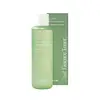What's inside
What's inside
 Key Ingredients
Key Ingredients

 Benefits
Benefits

 Ingredients Side-by-side
Ingredients Side-by-side

Leontopodium Alpinum Callus Culture Extract
AntioxidantClitoria Ternatea Flower Extract
Skin ConditioningWater
Skin ConditioningGlycerin
HumectantButylene Glycol
HumectantGlycereth-26
Humectant1,2-Hexanediol
Skin ConditioningDiethoxyethyl Succinate
SolventHydroxyacetophenone
AntioxidantTrehalose
HumectantGlycosyl Trehalose
Emulsion StabilisingHydrogenated Starch Hydrolysate
HumectantCarbomer
Emulsion StabilisingTromethamine
BufferingHydrolyzed Hyaluronic Acid
HumectantAdenosine
Skin ConditioningLactobacillus/Soybean Ferment Extract
Skin ConditioningSodium Hyaluronate
HumectantCarnosine
Skin ConditioningEthylhexylglycerin
Skin ConditioningHydroxypropyltrimonium Hyaluronate
Acetyl Hexapeptide-8
HumectantCopper Tripeptide-1
Skin ConditioningGlutathione
Palmitoyl Pentapeptide-4
Skin ConditioningSodium Acetylated Hyaluronate
HumectantOligopeptide-29
AntioxidantOligopeptide-32
AntiseborrhoeicHyaluronic Acid
HumectantHydrolyzed Sodium Hyaluronate
Skin ConditioningSodium Hyaluronate Crosspolymer
HumectantPotassium Hyaluronate
Skin ConditioningLeontopodium Alpinum Callus Culture Extract, Clitoria Ternatea Flower Extract, Water, Glycerin, Butylene Glycol, Glycereth-26, 1,2-Hexanediol, Diethoxyethyl Succinate, Hydroxyacetophenone, Trehalose, Glycosyl Trehalose, Hydrogenated Starch Hydrolysate, Carbomer, Tromethamine, Hydrolyzed Hyaluronic Acid, Adenosine, Lactobacillus/Soybean Ferment Extract, Sodium Hyaluronate, Carnosine, Ethylhexylglycerin, Hydroxypropyltrimonium Hyaluronate, Acetyl Hexapeptide-8, Copper Tripeptide-1, Glutathione, Palmitoyl Pentapeptide-4, Sodium Acetylated Hyaluronate, Oligopeptide-29, Oligopeptide-32, Hyaluronic Acid, Hydrolyzed Sodium Hyaluronate, Sodium Hyaluronate Crosspolymer, Potassium Hyaluronate
Houttuynia Cordata Extract
Skin ConditioningArtemisia Annua Leaf Extract
AntimicrobialMelaleuca Alternifolia Leaf Extract
PerfumingCentella Asiatica Extract
CleansingWater
Skin ConditioningGlycerin
HumectantButylene Glycol
HumectantDipropylene Glycol
Humectant1,2-Hexanediol
Skin ConditioningBetaine
HumectantHydroxyacetophenone
AntioxidantCarbomer
Emulsion StabilisingTromethamine
BufferingAllantoin
Skin ConditioningDipotassium Glycyrrhizate
HumectantEthylhexylglycerin
Skin ConditioningDisodium EDTA
Lactococcus Ferment Lysate
Skin ConditioningBifida Ferment Lysate
Skin ConditioningLactobacillus Ferment Lysate
Skin ConditioningMadecassoside
AntioxidantAsiaticoside
AntioxidantMadecassic Acid
Skin ConditioningAsiatic Acid
Skin ConditioningHydrolyzed Hyaluronic Acid
HumectantHouttuynia Cordata Extract, Artemisia Annua Leaf Extract, Melaleuca Alternifolia Leaf Extract, Centella Asiatica Extract, Water, Glycerin, Butylene Glycol, Dipropylene Glycol, 1,2-Hexanediol, Betaine, Hydroxyacetophenone, Carbomer, Tromethamine, Allantoin, Dipotassium Glycyrrhizate, Ethylhexylglycerin, Disodium EDTA, Lactococcus Ferment Lysate, Bifida Ferment Lysate, Lactobacillus Ferment Lysate, Madecassoside, Asiaticoside, Madecassic Acid, Asiatic Acid, Hydrolyzed Hyaluronic Acid
Ingredients Explained
These ingredients are found in both products.
Ingredients higher up in an ingredient list are typically present in a larger amount.
1,2-Hexanediol is a synthetic liquid and another multi-functional powerhouse.
It is a:
- Humectant, drawing moisture into the skin
- Emollient, helping to soften skin
- Solvent, dispersing and stabilizing formulas
- Preservative booster, enhancing the antimicrobial activity of other preservatives
Butylene Glycol (or BG) is used within cosmetic products for a few different reasons:
Overall, Butylene Glycol is a safe and well-rounded ingredient that works well with other ingredients.
Though this ingredient works well with most skin types, some people with sensitive skin may experience a reaction such as allergic rashes, closed comedones, or itchiness.
Learn more about Butylene GlycolCarbomer is a polymer of acrylic acid. Its main role is to create a gel consistency.
A high amount of carbomer can cause pilling or balling up of products. Don't worry, most products contain 1% or less of carbomer.
Ethylhexylglycerin (we can't pronounce this either) is commonly used as a preservative and skin softener. It is derived from glyceryl.
You might see Ethylhexylglycerin often paired with other preservatives such as phenoxyethanol. Ethylhexylglycerin has been found to increase the effectiveness of these other preservatives.
Glycerin is already naturally found in your skin. It helps moisturize and protect your skin.
A study from 2016 found glycerin to be more effective as a humectant than AHAs and hyaluronic acid.
As a humectant, it helps the skin stay hydrated by pulling moisture to your skin. The low molecular weight of glycerin allows it to pull moisture into the deeper layers of your skin.
Hydrated skin improves your skin barrier; Your skin barrier helps protect against irritants and bacteria.
Glycerin has also been found to have antimicrobial and antiviral properties. Due to these properties, glycerin is often used in wound and burn treatments.
In cosmetics, glycerin is usually derived from plants such as soybean or palm. However, it can also be sourced from animals, such as tallow or animal fat.
This ingredient is organic, colorless, odorless, and non-toxic.
Glycerin is the name for this ingredient in American English. British English uses Glycerol/Glycerine.
Learn more about GlycerinHydrolyzed Hyaluronic Acid is a form of hyaluronic acid. It is created by the hydrolysis of hyaluronic acid with a high molecular weight. Once created, Hydrolyzed Hyaluronic Acid has a low molecular weight.
Low molecular weight HA has been shown to hydrate and increase elasticity of the skin. Increasing elasticity is also associated with reduction of wrinkle depth.
One study found topical low molecular weight hyaluronic acid may be considered for the treatment of rosacea in the adult population. However, we always recommend speaking with a professional about your skin concerns.
Hyaluronic acids are a humectant. This means they draw moisture from the air. Hyaluronic acids help moisturize, soothe, and protect the skin.
Read more about other common forms of hyaluronic acid:
Learn more about Hydrolyzed Hyaluronic AcidHydroxyacetophenone is antioxidant with skin conditioning and soothing properties. It also boosts the efficiency of preservatives.
This ingredient is not irritating or sensitizing.
Tromethamine helps balance the pH and improve the texture of a product. It is synthetically created.
As an emulsifier, Tromethamine prevents oil and water ingredients from separating. This helps stabilize the product and elongate a product's shelf life. Tromethamine also makes a product thicker.
Tromethamine helps balance the pH level of a product. Normal pH level of skin is slightly acidic (~4.75-5.5). The acidity of our skin is maintained by our glands and skin biome. Being slightly acidic allows our skin to create an "acid mantle". This acid mantle is a thin barrier that protects our skin from bacteria and contaminants.
Oral Tromethanmine is an anti-inflammatory drug but plays the role of masking, adding fragrance, and/or balancing pH in skincare.
1,3-Propanediol, 2-amino-2-(hydroxymethyl)-
Learn more about TromethamineWater. It's the most common cosmetic ingredient of all. You'll usually see it at the top of ingredient lists, meaning that it makes up the largest part of the product.
So why is it so popular? Water most often acts as a solvent - this means that it helps dissolve other ingredients into the formulation.
You'll also recognize water as that liquid we all need to stay alive. If you see this, drink a glass of water. Stay hydrated!
Learn more about Water